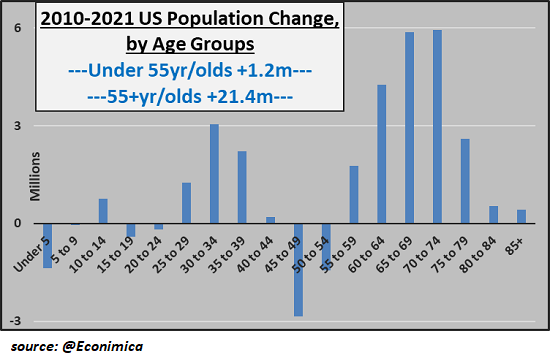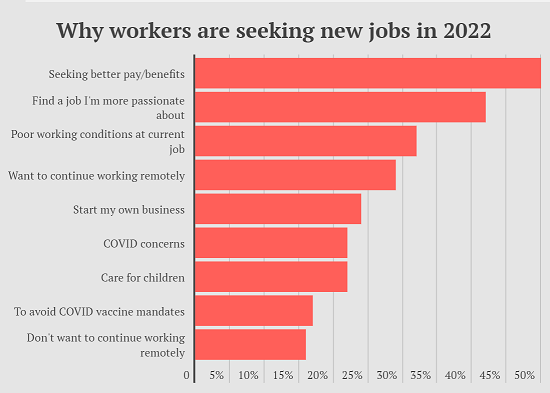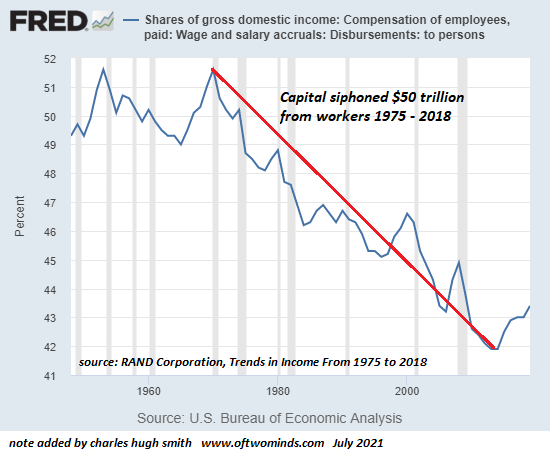It’s getting hard to fill toxic low-pay jobs, and that’s not going to change. The nature of work and the labor market are changing in ways few discern or perhaps are willing to discern because these changes are disrupting the exploitive system they want to remain unchanged. But refusing to discern change doesn’t stop change. It just leaves us unprepared to deal with fast-changing realities. There are multiple systemic reasons why work and the labor force are changing: demographics, the rigged economy, extremes of inequality, limits of technology and “garbage in, garbage out” lifestyle / health issues. Demographics. Take a glance at the chart below showing how the population of the U.S. changed between 2010 and 2020. (Chart courtesy of @Econimica). America’s
Topics:
Charles Hugh Smith considers the following as important: 5.) Charles Hugh Smith, 5) Global Macro, Featured, newsletter
This could be interesting, too:
Nachrichten Ticker - www.finanzen.ch writes Die Performance der Kryptowährungen in KW 9: Das hat sich bei Bitcoin, Ether & Co. getan
Nachrichten Ticker - www.finanzen.ch writes Wer verbirgt sich hinter der Ethereum-Technologie?
Martin Hartmann writes Eine Analyse nach den Lehren von Milton Friedman
Marc Chandler writes March 2025 Monthly
It’s getting hard to fill toxic low-pay jobs, and that’s not going to change.
The nature of work and the labor market are changing in ways few discern or perhaps are willing to discern because these changes are disrupting the exploitive system they want to remain unchanged. But refusing to discern change doesn’t stop change. It just leaves us unprepared to deal with fast-changing realities.
There are multiple systemic reasons why work and the labor force are changing: demographics, the rigged economy, extremes of inequality, limits of technology and “garbage in, garbage out” lifestyle / health issues.
Demographics. Take a glance at the chart below showing how the population of the U.S. changed between 2010 and 2020. (Chart courtesy of @Econimica). America’s population expanded by 22.5 million, but of this net increase only +1.2 million were under the age of 55; the vast majority– 21.4 million –were 55 or older.
Young people enter the workforce, the elderly retire. The smaller the population of young people, the smaller the workforce. The wrinkle here is that a great many more people 65 and older are continuing to work rather then retire in the U.S., extending their working life. This has stabilized the size of the workforce (around 160 million) even as the population has aged.
There are many reasons for this, including 1) older people with only Social Security retirement income need to keep working to pay their bills; 2) some people enjoy their work and don’t want to retire and 3) hybrid work and part-time work is a good fit for many healthy over-65 workers.
| But a rapidly aging population brings with it a rapidly aging workforce, and this has consequences. Some older workers may be desperate enough to take toxic low-pay jobs, but many are no longer physically able to do these jobs. The majority of over-65 workers are working because the work suits them. Once it doesn’t suit them, i.e. it’s toxic and unrewarding, they’re gone.
Toxic work, toxic economy: At the other end of the age scale, young people are awakening to the wretched reality of an economy rigged to protect insiders and enrich the already-rich. If you set out to design an economy that was optimized to protect insiders and reward the already-wealthy, you’d end up with the developed-world economy. This is equally true in every nation, from China to the EU to the U.S. to every developed nation. Workers are awakening to the meager rewards of being a slave to their ambition to claw their way into the upper-middle class. In an economy optimized for rampant inequality, the ambitious must sacrifice everything for the essentially meaningless baubles of a high-stress upper-middle class existence. So you sacrifice your health, family and life to claw your way to a high salary, and for what? Nobody notices or cares, it’s pointless. You’ll never be as rich or famous as some kid reviewing toys online, and you’re buying into scams that just enrich others. |
|
| The verboten truth is a lower-stress lifestyle is far more rewarding and enjoyable than a high-stress enslaved-to-ambition lifestyle. Stripped of advertising flim-flam, a $25,000 car is essentially the equal of cars that cost three times as much. Is it really worth sacrificing everything that’s truly meaningful in your life to have all those extra horsepower idling unused in a traffic jam, heated seats and an incomprehensibly complicated stereo system? No.
A simple house you actually own is more satisfying than a bloated McMansion that enslaves you to stupidly high property taxes and crushing mortgage payments. What’s actually precious isn’t the baubles of a high-stress salary, it’s your time.‘A bigger paycheck? I’d rather watch the sunset!’: is this the end of ambition? Simply put, people are finding ways to survive without taking toxic low-pay jobs. After 45 years of capital pillaging labor, the asymmetry of capital and labor is finally reversing.The chart below of labor’s share of the national income shows that the trend has finally reversed, and wages (as a share of the national income) are rising. Combine a smaller, older workforce with a rigged economy offering meager rewards, and the result is higher wages.The chart below listing the many reasons why people are quitting and seeking new jobs is instructive. The fantasy that robots will do all the work is deflating. We were promised 100% fully autonomous self-driving cars by 2018–look, no steering wheel!–and here we are. (Never mind the larger question: as the global economy unravels, is the solution really self-driving vehicles?) |
|
| If robots are so cheap and versatile, then why does Amazon have 1.6 million human employees? They seem like pretty sharp operators; would they really bother having human workers if robots could do all the work, and do it without healthcare insurance?
Technology has physical and financial limits. PR videos may wow us, but how does the robot actually make somebody money? Sadly, our garbage in, garbage out lifestyle is taking a toll on the health of the workforce. A great many people are no longer physically or psychologically able to meet the demands of employers who need highly productive workers to compete. These demands are burning workers out across the entire spectrum of work, from the well-compensated to the poorly compensated. (This is why I wrote my book When You Can’t Go On: Burnout, Reckoning and Renewal.) Though few financial pundits seem to have noticed, it’s become extremely burdensome to start and operate your own small business.Self-employment was once within relatively easy reach of anyone who wanted to strike out on their own. Those days are long past. Now a great deal is demanded of anyone who wants to launch a formal business, and the compliance and tax/fee burdens increase every year. Beneath all the rah-rah, sacrificing your life to further enrich the already-rich is a bad deal.Insiders have hard-wired the system to protect and benefit themselves, and so the game of clawing one’s way into the higher rungs of tax-donkey / slave-to-ambition is for chumps. It’s getting hard to fill toxic low-pay jobs, and that’s not going to change. |
Tags: Featured,newsletter



